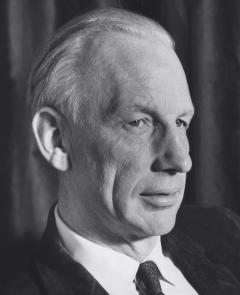Professor William Michael Court Brown
MRC Clinical and Population Cytogenetics Unit Director 1956- 1969

William Michael Court Brown was born in the North of England, near Carlisle, in 1918. He was educated at Fettes College Edinburgh and St. Andrews University where he graduated in medicine in 1942.
He specialised in radiotherapy and after taking the Diploma in Medical Radiology in Edinburgh University joined the staff of the Royal Infirmary of Edinburgh and became a consultant in radiotherapy, a lecturer in radiology in the University of Edinburgh and Deputy Director of the Department of Radiotherapy.
His work in clinical radiology stimulated a profound interest in the affect of radiation on man and in 1950 he joined the external staff of the Medical Research Council at the Post Graduate School of Medicine of London where he worked at first on the acute effects of radiation. His interest soon shifted to the long term effects of radiation and in 1955 together with Dr J D Abbott he reported an increased incidence of leukaemia amongst patients who had been treated with x-rays for ankylosing spondylitis. This work led to his collaboration with Richard Doll in a study which was urgently required by the Medical Research Council for government and a nation alarmed by the global effects of the recently exploded hydrogen bomb. This monumental study carried out in less than a year provided a solid factual basis for the association between radiation and leukaemia and established a simple proportional relationship between Leukaemia incidences. This later finding focussed attention on the possible deleterious effects of small doses of radiation on large population. It was for this work that both Court Brown and Doll were awarded the O.B.E. in 1957.
Even at this stage Court Brown believed that the mechanism of leukaemia induction could only be determined by basic studies at the cellular level. He was already conscious of the possible effects of radiation on the genetic material of the cell and was much influenced by the work of Tjio and Levan on human chromosomes and by the work of Ford on the chromosomes of neoplasms in rodents. Thus when he returned to Edinburgh in1956 as Director of the MRC group he had already resolved to build around him a team of clinicians and biologists who would look for evidence of genetic change in radiation induced neoplasms in man. The development of techniques for chromosome analysis by this team lead to a change in the emphasis of the work and the unit evolved into the MRC Clinical and Population Cytogenetics Unit.
Soon the technology of human cytogenetics was established and it was characteristic of Court Brown’s approach to research that he would exploit new techniques. His collaboration with Dr Patricia Jacobs and others produced some of the most important advances in this field including the first description of an XXY male and of a triple X female, and the recognition of the significance of the XYY male.
Court Brown’s vision as early as 1960 led to the development of human cytogenetics in Edinburgh being radically different to that in most other centres. He decided that the work should be principally on defined populations. In this way the relative importance of chromosome aberrations in specific groups such as females with primary amenorrhoea could be determined. This approach also stimulated McLean’s work on nuclear sexing of newborn populations, which was the preliminary to the now extensive cytogenetic studies, which have been done on normal populations. It was in that latter work that he was most deeply involved at the time of his death. He opened up a field which he termed human population cytogenetics that would go on to yield its most valuable rewards, e.g. in the fields of linkage and from the study of individuals with abnormal sex chromosomes constitutions, in the field of human behaviour.
A painstaking attention to accuracy regardless of the amount of work involved was another feature of his approach to research. The massive amount of work he contemplated in the future made it inevitable that he should consider the automation of chromosome analysis and already major steps have been taken towards his goal. Success in this field will be in large due to his untiring efforts.


